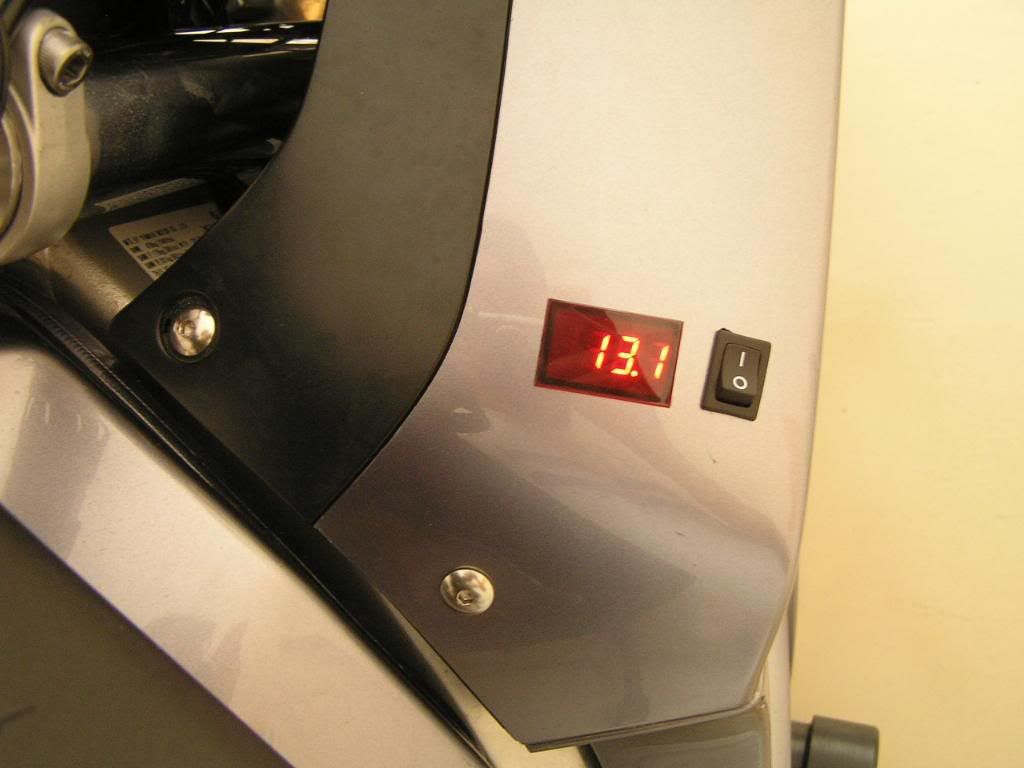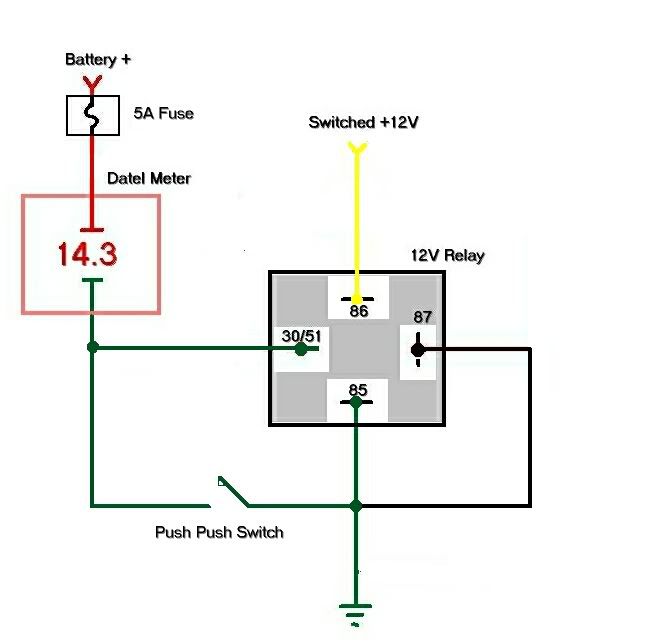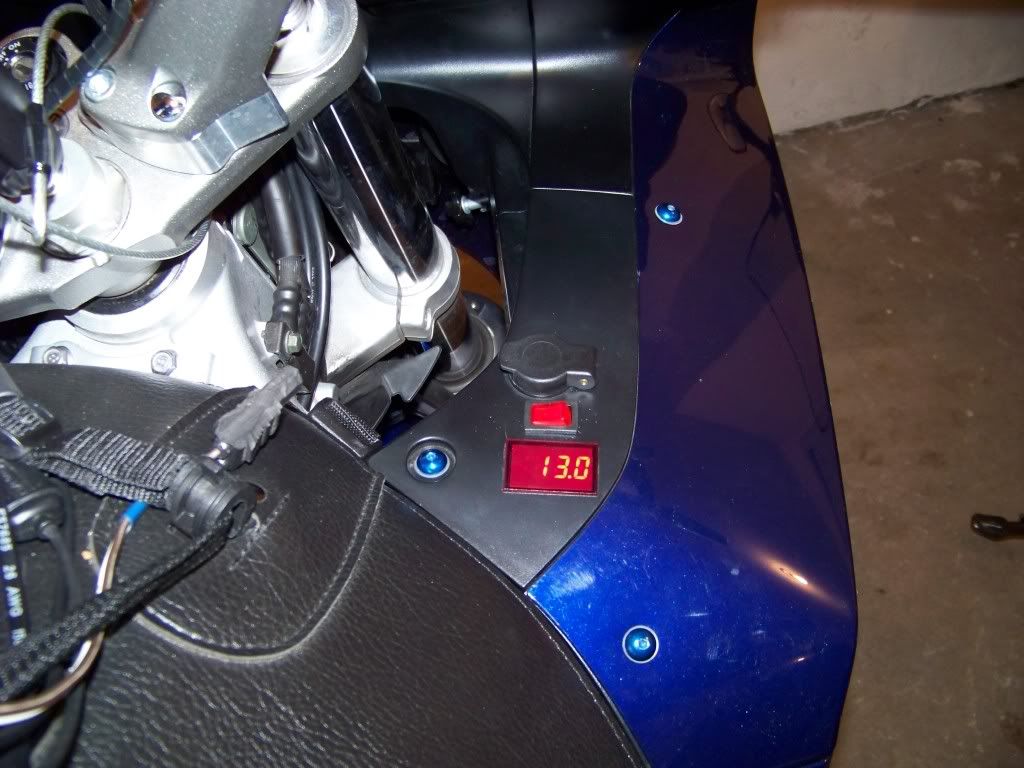I originally bought my Datel Digital 2-wire Voltmeter at DigitalMeter.com when I first bought my FJR. I got the DMS-20PC-1-DCM model which is the standard red LED 2 1/2 digit model.
I have been very happy with everything about these meters. That is, except for one thing, which is due entirely to the way that I wired it. I wired the meter directly off of the 12V relay, which I also use to power my accessories. I did just this so that the meter would automatically switch on and off with the ignition switch for convenience. But this also means that I am not getting an accurate representation of the voltage charging the battery whenever I have any higher wattage electrical gear on like heated grips, gloves, aux lights, etc.
The reason for the inaccuracy in this configuration is that the wiring and relay contacts have some finite (albeit small) amount of resistance. When the only thing that the accessory relay is powering is the Datel, which draws a mere 7 ma, then it is reading true battery voltage. But as the other devices pull more current through the relay the voltage drop on the resistance of the distribution system becomes increasingly significant, causing the meter to read below actual battery (and charging) voltage.
The other "problem" with that original configuration is that I am unable to monitor the battery voltage without the load of the bike's electrical system. I'd like to be able to momentarily turn on the meter without turning on the bike, like maybe when checking how well the trickle charger has been working in the winter-time in the garage, in addition to having it automatically come on and off with the ignition switch. That's the "cake and eat it too" part.
So, what I've decided is that I will have to buy another 12V relay which will be dedicated to just powering the meter. I will be wiring this new relay directly from the battery. I will wire in the new relay's trigger signal from the existing terminal strip, which is fed from the existing accessory relay. I don't care what the voltage is there as this will just be used to switch the relay on and off. I'll also be adding a normally open, single pole, momentary switch, to be located on the dashboard somewhere, that will energize the relay when the bike's ignition is not on.
Here's my rudimentary wiring diagram for anyone else that wants to do similar.

This new relay doesn't need to be one of the ubiquitous, monstrously big 30-40 amp automotive relays we usually use for everything on our bikes, but it should be water tight and weather resistant. So those may be the cheapest and most readily available ones around. That's why I used the conventional terminal numbers for those relays in the diagram. The wiring for this relay circuit from the battery also does not need to be very large as it will only need to support the 7 ma draw of the meter. It will, however, need to be fused for safety, as shown since it coming right off the battery.
I'll try to remember to take pictures of the final assembly, but it really won't be anything all that fancy. Should work great though.
I have been very happy with everything about these meters. That is, except for one thing, which is due entirely to the way that I wired it. I wired the meter directly off of the 12V relay, which I also use to power my accessories. I did just this so that the meter would automatically switch on and off with the ignition switch for convenience. But this also means that I am not getting an accurate representation of the voltage charging the battery whenever I have any higher wattage electrical gear on like heated grips, gloves, aux lights, etc.
The reason for the inaccuracy in this configuration is that the wiring and relay contacts have some finite (albeit small) amount of resistance. When the only thing that the accessory relay is powering is the Datel, which draws a mere 7 ma, then it is reading true battery voltage. But as the other devices pull more current through the relay the voltage drop on the resistance of the distribution system becomes increasingly significant, causing the meter to read below actual battery (and charging) voltage.
The other "problem" with that original configuration is that I am unable to monitor the battery voltage without the load of the bike's electrical system. I'd like to be able to momentarily turn on the meter without turning on the bike, like maybe when checking how well the trickle charger has been working in the winter-time in the garage, in addition to having it automatically come on and off with the ignition switch. That's the "cake and eat it too" part.
So, what I've decided is that I will have to buy another 12V relay which will be dedicated to just powering the meter. I will be wiring this new relay directly from the battery. I will wire in the new relay's trigger signal from the existing terminal strip, which is fed from the existing accessory relay. I don't care what the voltage is there as this will just be used to switch the relay on and off. I'll also be adding a normally open, single pole, momentary switch, to be located on the dashboard somewhere, that will energize the relay when the bike's ignition is not on.
Here's my rudimentary wiring diagram for anyone else that wants to do similar.

This new relay doesn't need to be one of the ubiquitous, monstrously big 30-40 amp automotive relays we usually use for everything on our bikes, but it should be water tight and weather resistant. So those may be the cheapest and most readily available ones around. That's why I used the conventional terminal numbers for those relays in the diagram. The wiring for this relay circuit from the battery also does not need to be very large as it will only need to support the 7 ma draw of the meter. It will, however, need to be fused for safety, as shown since it coming right off the battery.
I'll try to remember to take pictures of the final assembly, but it really won't be anything all that fancy. Should work great though.
Last edited by a moderator:




































































